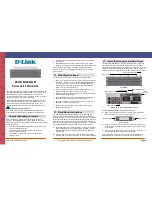
Hitachi Command Control Interface (CCI) User and Reference Guide
183
Parameter Value
Options
-h:
Displays Help/Usage and version information.
-q:
Terminates the interactive mode and exits this command.
-z or -zx (OpenVMS cannot use the -zx option):
Makes the pairresync command enter the interactive
mode. The -zx option guards performing of the HORCM in the interactive mode. When this option detects a
HORCM shut down, interactive mode terminates.
-I[H][M][instance#] or -I[TC][SI][instance#] Specifies the command as [HORC]/[HOMRCF], and used for
specifying instance# of HORCM.
-g <group>:
This option is used to specify a group name defined in the configuration definition file. This
option must always be specified. The command is executed for the specified group unless the -d <pair Vol>
option is specified.
-d <pair Vol>:
Specifies a paired logical volume name defined in the configuration definition file. When this
option is specified, the command is executed for the specified paired logical volumes.
-d[g] <raw_device> [MU#]:
Searches a group on the configuration definition file (local instance) for the
specified raw_device, and if the specified raw_device is contained in the group, the target volume is
executed as the paired logical volume (-d) or group (-dg). This option is effective without specification of “-g
<group>“ option. If the specified the raw_device is contained in two or more groups, the command is
executed on the first group.
-d[g] <seq#> <LDEV#> [MU#]:
Searches a group on the configuration definition file (local instance) for the
specified LDEV, and if the specified LDEV is contained in the group, the target volume is executed as the
paired logical volume (-d) or group (-dg). This option is effective without specification of “-g <group>“ option.
If the specified LDEV is contained in two or more groups, the command is executed on the first group. The
<seq #> <LDEV #> values can be specified in hexadecimal (by addition of “0x “) or decimal notation.
-FHORC [MU#] or -FCA [MU#]:
Forcibly specifies a cascading Hitachi TrueCopy volume for specified pair
logical volumes on ShadowImage environment (see example in Figure 4.7). If the -l option is specified, this
option resyncs a cascading TrueCopy volume on a local host (near site). If no -l option is specified, this
option resyncs a cascading TrueCopy volume on a remote host (far site). The target TrueCopy volume must
be a P-VOL, the -swapp option cannot be specified.
-FMRCF [MU#] or -FBC [MU#]:
Forcibly specifies a cascading ShadowImage volume for specified pair
logical volumes on TrueCopy environment (see example in Figure 4.8). If the -l option is specified, this
option resyncs a cascading ShadowImage volume on a local host (near site). If no -l option is specified, this
option resyncs a cascading ShadowImage volume on a remote host (far site). The target ShadowImage
volume must be a P-VOL.
-swaps with -FHORC [MU#]
This option is used to swap the cascading UR volume from the primary node for failback.
In failback operation from 3DC Cascade Site Failure, If a user want to failback to DC1 from DC3 directly,
it will be needed to operate all cascading volume from DC1.
In order to make this operation possible, RAID Manager supports “pairresync -swaps -FHORC” option that
swaps UR volume on the cascading CA-Sync/UR volume.
-c <size>:
Specify the copy pace for the resync operation (range = 1 to 15 track extents). If not specified,
the value used for paircreate is used.
-nomsg:
Suppresses messages to be displayed when this command is executed. It is used to execute this
command from a user program. This option must be specified at the beginning of a command argument.
The command execution log is not affected by this option.
-l: When this option cannot utilize the remote host for host down, this option enables a pairresync operation
by the local host only. The target volume of the local host must be P-VOL. (ShadowImage volumes are able
to resync only SVOL.)
-restore (ShadowImage only):
Performs reverse resync (from secondary volume to primary volume).
swaps (TrueCopy only):
Executed from the SVOL side when there is no host on the PVOL side to help.
Typically executed in PSUS state to facilitate “fast failback” without requiring a full copy. In Figure 4.9, the
left side shows T0 for both the PVOL and SVOL (before command execution), and the right side shows T1,
after the command has executed. For both -swaps and -swapp, the delta data from the original SVOL
becomes dominant and is copied to the original PVOL, then the S/PVOL designations are swapped.
swapp (TrueCopy only):
Executes the equivalent of a -swaps from the original PVOL side. Unlike -swaps,
-swapp does require the cooperation of hosts at both sides.
-fq <mode> (9900V ShadowImage only)
This option is used to specify the mode whether “pairresync” is performed or not as “QUICK”.
mode = normal
pairresync will be performed as Non quick mode regardless of setting of $HORCC_RSYN environment
variable and/or the system option mode 87 via SVP.
mode = quick
pairresync will be performed as Quick Resync regardless of setting of $HORCC_RSYN environment
Summary of Contents for TAGMASTORE MK-90RD011-25
Page 2: ......
Page 8: ...viii Preface ...
Page 18: ...xviii Contents ...
Page 180: ...162 Chapter 3 Preparing for CCI Operations ...
Page 250: ...232 Chapter 4 Performing CCI Operations Vol Type logical unit LU type e g OPEN V OPEN 9 ...
Page 370: ...352 Chapter 5 Troubleshooting ...
Page 388: ...370 Acronyms and Abbreviations ...
















































